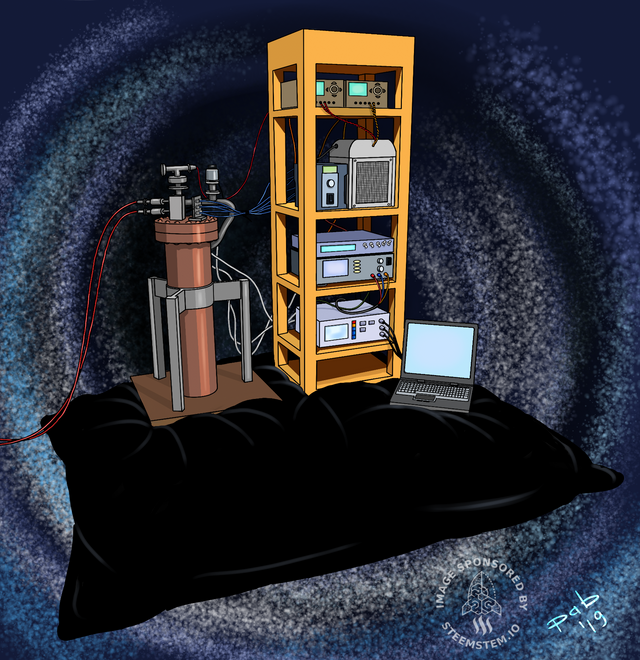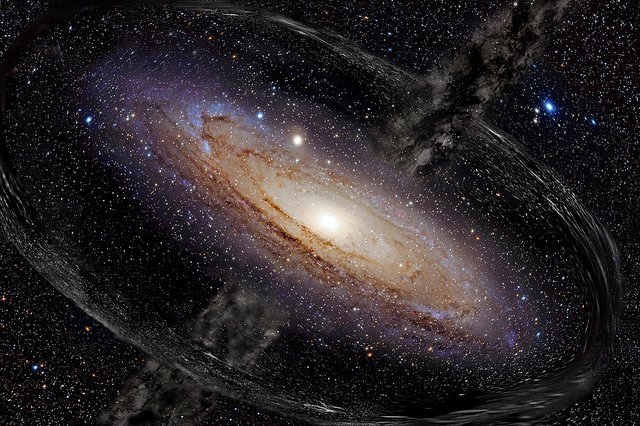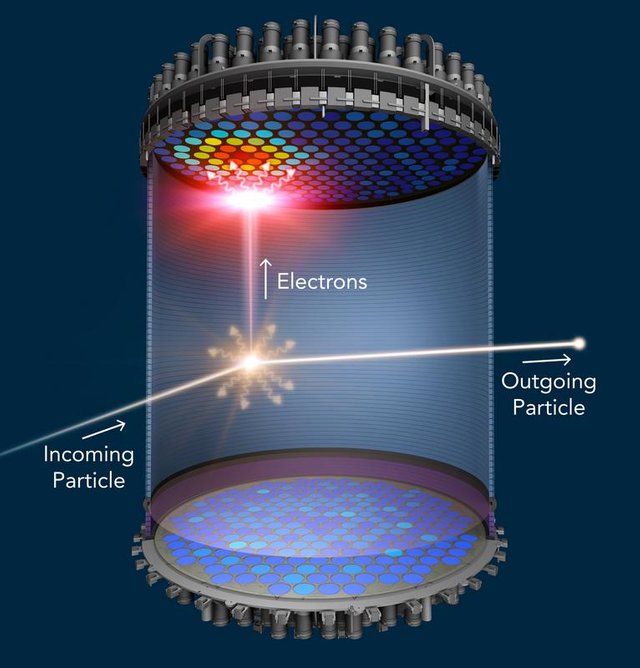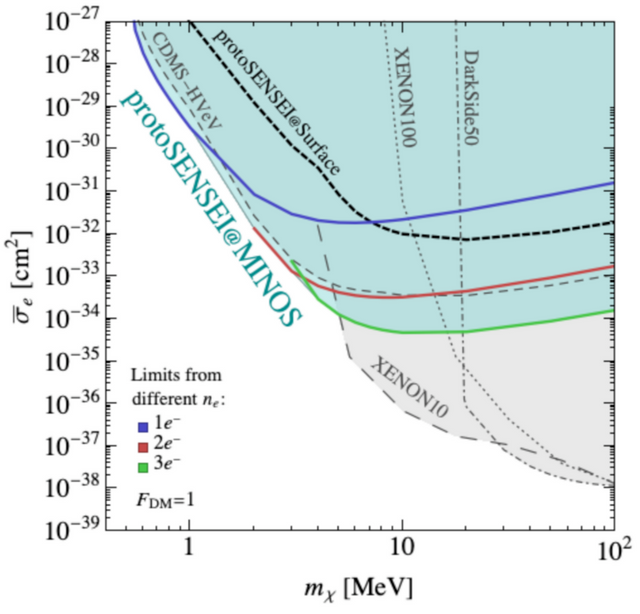A new proto-sensei to get a better grip on dark matter
The life of a particle physicist may be full of various tasks, as the job goes well beyond just doing research. The amount of work that ended on me reached levels such that I have been mostly invisible on Steem for the last three weeks. This happens… The situation is slightly better now, although not optimal yet.
After having resumed my SteemSTEM activities (new developments on steemstem.io, curation activities, visible presence on our discord server, etc.), it is now time to start writing about physics again.

[image credits: @pab.ink]
The topic today concerns dark matter and the Sensei experiment, that consists in a new type of experiments targeting the nature of dark matter.
Whilst a direct dark matter observation consists in one of the major goals of (astro)particle physics today, dark matter managed to stay elusive so far.
The reason could actually be simple. All dark matter direct detection experiments target heavyish dark matter, with a mass in the same ballpark as those of the heavy Standard Model particles.
But what if dark matter is lighter? This is where Sensei comes into the game! And this post…
Dark matter detection on Earth
Dark matter is evidenced by numerous measurements ans observations.

[image credits: Maxwell Hamilton (CC BY 2.0)]
For instance, one can analyze the the fossil radiation left over for the Big Bang and see that the universe actually contains a lot of dark matter (5 times more than matter).
One could similarly try to explain the motion of stars or the bending of light in space. This can easily been done with dark matter.
And even more… But let’s stop here.
These many hints for dark matter triggered a huge experimental effort to try to directly detect dark matter on Earth with the aim of unravelling its properties. The principle behind these experiments is simple.
Dark matter is said to be dark for a good reason: it is very weakly interacting with anything around. This means, it is non-sensitive to the strong and electromagnetic interactions, that are the strongest forces we know about. However, weakly-interacting does not mean non-interacting. If we wait long enough and use a big enough detector, we may actually observe a dark matter interaction with normal matter.
This is the key point behind by all experiments targeting dark matter direct detection.

[image credits: SLAC]
We start with a large detector full of material, and we wait until a dark matter particle gets into the detector and hits one of the atomic nuclei of the detector.
We may however to wait for a long moment, as the probability of such an event is small (as dark matter is dark, as said above). This probability is however non-zero, so that the event may actually happen at some point, if we wait long enough.
Consequently to the choc, the hit nucleus recoils a little bit. As the detector is surrounded by sensors and cameras, this recoil is observed and analyzed.
This allows us to go back to what initiated the choc: dark matter.
All those experiments are so far returning null results, so that dark matter models are more and more constrained. But we still have room before claiming there is no hope.
Detecting dark matter detection with Sensei
Dark matter direct detection experiments are however not sensitive to light dark matter that cannot generate any observable hit in the detector material. As light dark matter is not energetic enough for nuclear recoils (that are employed in traditional dark matter direct search experiments), the next idea was to focus on electronic recoils.
Direct detection experiments have therefore started to be tuned to be sensitive to such electronic recoils. However, this turned out to be quite limited. And here is Sensei for closing the gap!
Unlike for nuclear-recoil-based apparatuses that rely on noble liquids as detector materials, Sensei relies on a solid-state detector. Furthermore, it was demonstrated a couple of years ago that such a detector could be used to observe single electrons using special techniques (high-voltage cryogenics and signal amplifiers).
This is all what was needed to build a Sensei prototype (called protoSENSEI) that is active and already delivers results. An example is shown below.

[image credits: arXiv]
In this figure, the x-axis corresponds to the dark matter mass and the y-axis represents the interaction rate of dark matter with electrons. The colored areas are those excluded by the nuclear-recoil-based experiments like Xenon or DarkSide and by Sensei.
Whilst electronic recoils can be measured in experiments like Xenon10 or Xenon100, as said above, they do not do as good as what does protoSENSEI. ProtoSENSEI is indeed sensitive to quite light dark matter (the green area extents to the left), that was unobservable in these type of experiments until very recently. In passing, CDMS-HVeV, a new apparatus that also targets electronic recoils, also does quite well.
Take-home message
Dark matter direct detection usually relies on the nuclear recoil generated by the interaction of a dark matter particle going through Earth with a noble-liquid detector. However, nuclear recoils necessitate some energy that is not available for light dark matter.
For this reason, physicists have moved on with electronic recoils. However, experiments based on noble liquid detectors have been found to be not greatly sensitive to that. Sensei is a novel type of experiment relying on a solid-state detector. This different technology has opened the door to light dark matter, and the prototype of this experiment is currently delivering impressive results.
The dark matter outlook is therefore very bright: if dark matter is light and can excite electrons, we may find it in the next decades!
SteemSTEM
SteemSTEM aims to make Steem a better place for Science, Technology, Engineering and Mathematics (STEM) and to build a science communication platform on Steem.
Make sure to follow SteemSTEM on steemstem.io, Steemit, Facebook, Twitter and Instagram to always be up-to-date on our latest news and ideas. Please also consider to support the project by supporting our witness (@stem.witness) or by delegating to @steemstem for a ROI of 65% of our curation rewards (quick delegation links: 50SP | 100SP | 500SP | 1000SP | 5000SP | 10000SP).
Hi @lemouth, I want to thank you, and the only way I can do, is drawing.

(in some my previous comic, @aboutcoolscience suggested me to draw you like a mammuth and now is the only way where I can imagine you)
Ahaha I love it!
Me too!
Thanks a lot @pab.ink! I love it! You can draw me as a mammoth, this is very fine (and somehow well known today). If you want something more realistic, my true face is available from here together with the other SteemSTEM managers :)
Cheers!
Nice to meet you :-)
Glad to see you're back in action. I just made my first post in a while and it feels good.
This is the first time I've seen you mention sensei. I figured that had to be an acronym for something and my google search revealed that it stands for Sub Electron Noise Skipper-CCD Experimental Instrument. That made me think of something that's been bugging me about this dark matter detection. How do you avoid or account for noise in the detectors? My apologies if you've already covered it in a previous post.
I really enjoy writing, but I can only do that when I have free more time left from my work (and I use most this time to continue developing the app; for instance comment preview is new, and I am currently developing comment editing). I guess the similar applies to you as well. Time ...
To go back to your question, the key issue is to have a clean signal. The detector technology is such that the experiment is basically run in a background-free environment. Any event in which the noise is larger than expected is first rare, and next rejected.
There is some left-over background noise of course, but once it is small and well understood, anomalies (i.e. dark matter signals) can be easily seen. For instance, you casn check figure 1 in 1901.10478 and check the order of magnitude of the y-axis values. This gives you the tiny noise expectation.
Now, if you need the technological details on how to get there, I am afraid I can't answer (as I am a theorist :p). But all details can be found in 1706.00028.
Cool. Thanks for the detailed reply!
You are welcome! Sorry for not being able to give more technical details (but we are reaching the frontier of what I know ;) )
not very present on steemit atm myself so im running behind on physics lessons but as i am a force of chaos and a cat of shadows myself not seeing me doesnt mean im dead - especially since my state is always uncertain as i am a schroedingers cat nest and definitely don't behave when observed.
Which by all but human paper law makes me very normal from the quantum level up, but try explaining that to normal people ...
So i just read the mayans were a few years of an a dark matter hurricane will destroy the world however if it takes a lightyear of lead to halt neutrinos : And you need about a light year of lead to stop your typical neutrino. As a result of this, dark matter is incredibly fluffy and diffuse, which means even in our Solar System, by the heart of our galaxy, dark matter's effects are negligibly unobservable - i never considered particles to be fluffy ... - then i guess we should be safe for now as that would bring the chance of dark matter interacting with a planet this size pretty much down to the lifetime of a solar system of more ? probability-wise (? im not the numbers guy).
However as i am, despite my total lack of degrees in the formal sense of the word, not a complete idiot, i DO know that in essence almost all probability can be reduced to 50/50 since it's either yes or no
Which, in turn makes it a cosmic lottery and people DO win ...
I have to cut it short as i'm not feeling too well and i'll probably miss the replies as i have done for a few months now (this thing called life getting in my head && the way) but this should without doubt prove
that i'm still here :)
@lemouth
always a pleasure, glad i could find the focus to read something
As my presence is very low too, you will not have much to catch up. This is somehow a good news for you :D
This being said, I am glad to see you are still around.
To come back to the question: we don't need to stop dark matter, we only need to see traces from its passage through the detector. And those traces are exactly tiny nuclear or electornic recoils that can be meaured. We therefore need large, but not too large, apparatuses.
In the most optoimistic cases, we are expecting a few dark matter events. In the least optimistic ones, dark matter interactions are weaker and nothing should be seen. The problem of the word weak is that we are not sure how weak it should be. Very weak interactions are acceptable theoretically but do not give us many chances experimentally, for instance.
I hope this answer helps :)
I like it that there is now a bright future in the detection of dark matter (pun not intended).
Maybe in your next series you may explain further on the light bending phenomenon explanation with dark matter assuming it won't drag us in too deep into the rabbit hole :)
This was written on purpose, don't worry ;)
I already explained it in one paragraph in this previous post, for instance.
Ok, I just saw the explanation.
General relativity once again comes to the rescue :)
Strictly speaking, I am not sur there was anything to be rescued here, as everything was understood :D
This sounds almost like a gambler's fallacy :P
Very Eastern post, this time, Sensei!
It is not. There is some real science in there. However, hunting the invisible can often be compared with gambling. We know we may find something, but the odds to find nothing are even larger :D
Not guilty! I didn't choose the experiment name. ^^
Replying to test comment editing
Edit: here we gooooo
Edit Edit: Successfully edited with steemstem.io
Very cool! Did this just happen today? I think it was only yesterday when I was still looking for the edit button!
Lemouth pushed the update last night yeah. Slowly becoming more usable.
I am doing my best :D
Slowly and slowly we are getting there. Now I will port these changes to post editing: much faster and more stable. But this will be for next week or so...
Hi @lemouth!
Your post was upvoted by Utopian.io in cooperation with @steemstem - supporting knowledge, innovation and technological advancement on the Steem Blockchain.
Contribute to Open Source with utopian.io
Learn how to contribute on our website and join the new open source economy.
Want to chat? Join the Utopian Community on Discord https://discord.gg/h52nFrV